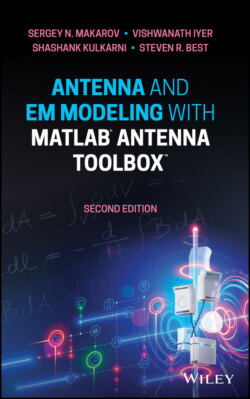Читать книгу Antenna and EM Modeling with MATLAB Antenna Toolbox - Sergey N. Makarov - Страница 23
1.5 POINT OF INTEREST: INPUT IMPEDANCE OF A DIPOLE ANTENNA AND ITS DEPENDENCE ON DIPOLE LENGTH
ОглавлениеIn order to become familiar with the problem of antenna matching, we now need a practical antenna example and a practical antenna impedance behavior. This example will also help us to define the antenna impedance bandwidth in future. To do so, we consider a cylindrical metal dipole antenna shown in Figure 1.4.
The antenna includes two dipole wings fed by a generator. In Figure 1.4, lA is the total dipole length, a is the dipole radius.
During the last 70 or so years, a lot of efforts have been made to develop a good analytical terminal dipole model. As a result, one can use the following proven semi‐analytical expression for the input dipole impedance [2]:
(1.14)
Figure 1.4 Dipole antenna for the evaluation of the reflection coefficient.
In Eq. (1.14), lA is the total dipole length, a is the dipole radius, z = klA/2, and is the wavenumber with c0 being the speed of light in vacuum.
If a strip or blade dipole of width t is considered, then aeq = t/4 [3] (providing the same equivalent capacitance of a dipole wing per unit length). We note here that a is the radius of a cylindrical dipole, while aeq is the equivalent radius of a wire approximation to the strip dipole. Eq. (1.14) holds for relatively short nonresonant dipoles and for half‐wave dipoles, i.e. in the frequency domain approximately given by
(1.15)
where fres ≡ c0/(2lA) is the resonant frequency of an idealized dipole having exactly a half‐wave resonance (c0 is again the speed of light) and fC is the center frequency of the band. This means that the ideal dipole resonates when its length is the half wavelength. When a monopole over an infinite ground plane is studied, the impedance in Eq. (1.14) halves.
